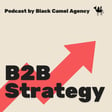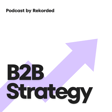Become a Creator today!Start creating today - Share your story with the world!
Start for free
00:00:00
00:00:01

09: Dark Linkedin & Linkedin Content Bridging (LINKEDIN Series)
Why do you get engagement on Linkedin posts but not enough clients? This is the answer to your problem... You aren't doing enough Linkedin Content Bridging.
This is the first episode of The Linkedin Series, where I do quick solo episodes specifically on B2B Linkedin marketing.
Transcript
Introduction to Dark LinkedIn and B2B Buying
00:00:00
Speaker
So today we are going to talk about dark LinkedIn. So what is dark LinkedIn? Well, for those in my audience, a lot of you are on LinkedIn.
00:00:10
Speaker
And I imagine a lot of you are agency owners and you are probably familiar with Chris Walker, the CEO of Refine Labs. He is the creator of the term called Dark Social. And basically what Dark Social is, is where B2B buying is happening where it can't be tracked. And the problem is, is that a lot of decisions are being made with touch points that are happening in social media and you can't track these.
00:00:36
Speaker
A lot of decisions are being made from people watching your videos on LinkedIn, but that can't really be tracked.
Untrackable LinkedIn Buying and Strategic Missteps
00:00:42
Speaker
And so because of that, a lot of people are making marketing strategies that don't have that included.
00:00:47
Speaker
And so I have realized that there is a big problem on LinkedIn and it is what I'm going to start calling dark LinkedIn. And basically the theory behind this is that LinkedIn buying happens in places you can't track. And this is why you're blindly doing the wrong things on LinkedIn. So you're leading your whole strategy based off of what you can track. So likes, comments, reposts, impressions, the few DMs that you get from an actual lead that isn't a cold pitch slap.
Optimizing Profiles and Pages for Lead Conversion
00:01:15
Speaker
And so this is all you can track and is leading your strategy. The problem is that it has very correlation with how people buy on LinkedIn. So 97% of my inbound calls have never interacted with my content. The profile was the most important step for 75% of my leads.
00:01:31
Speaker
88% became leads on my landing page while only 12% in my DM. So these, these are stats that I've gotten from what Chris Walker calls self-reported attribution. Basically I asked my leads about their journey, about how they found out about me, what led the journey, where it started and the steps that they took.
00:01:50
Speaker
And these are some pretty strong insights that have led me to see how important the profile in the landing page is. But the reason why so many on LinkedIn have just forgotten about this part is because they focus on what is being tracked. So likes, comments, engagement. Going back to that first stat that I talked about, 97% of my inbound calls never interacted with my content. So you might be getting a lot of engagement
00:02:14
Speaker
but they aren't converting, and I'll go into why in a little bit. But I first want to address the concept behind this.
00:02:21
Speaker
This is the invisible community. They are not liking your posts. They are not commenting. You have no idea who these people are. They're following you, but they're also listening to you and you don't know. And these people are called the invisible community because they are lurking.
Invisible LinkedIn Community and Strategic Engagement
00:02:35
Speaker
They're viewing your content. They're going to your profile and then they're going to the website to learn about how you solve their problem. And then they only show themselves when they see the value in reaching out. So these 97% of inbound calls never interact with my content
00:02:49
Speaker
And they only interacted with me at the end when they booked the call with me. And so if I only focused on what can be tracked, likes, comments, reposts, impressions, 97% of my inbound calls would never have happened. So why did all of these leads reach out? Because they found information about how I solved their problem with my service and proof that I solved their problem with other clients, which they found in my content.
00:03:11
Speaker
but also my profile and landing page. And so a big misconception on LinkedIn that I have found is that people will tell you make content so valuable, people will reach out. But this is not how people
00:03:25
Speaker
buy on LinkedIn. They buy on dark LinkedIn, the parts that you cannot track unless you're doing self-reported attribution like I have.
Content Strategies for LinkedIn Success
00:03:33
Speaker
People are not buying because they trust you. It's a part of it, but the reason they reach out is because they are motivated by solving their problems.
00:03:42
Speaker
and they only reach out because they know that you can solve their problems. So the more content you put out, the better you design your profile trying to get them to your landing page. It's basically giving them more access to this information about how you solve their problems with your service. So what I see a lot of people doing on LinkedIn is just putting out content that's just what they say, valuable. These are opinions, beliefs, trends, observations, and this is all great.
00:04:11
Speaker
it's keeping people listening to you. But if you never mentioned how you solve their problems with your service, they're not even they're not going to think about reaching out. They are not motivated by all that they are motivated
00:04:26
Speaker
by information, telling them how you can solve the problem with your service. And this is something that I really like that I've started to say a lot now. People are not motivated for information. They're not motivated to reach out for information. They are motivated to reach out by information. And so our job is to do
00:04:43
Speaker
LinkedIn content bridging was basic, which is basically giving access to that information earlier. So give more information about how you solve the problem with your service and your content in your profile and landing page. And a big problem is that a lot of people don't even have the profile designed or landing page.
00:05:01
Speaker
They only do content and that is a big part of the problem here is that the profile Profiles job should be getting them to the landing page where they have the most access to that information There's only so much in your content that you can talk about your service Because otherwise that just becomes selling and we don't want to do that. We can weave it in there But there's only so much we can talk about that without people not listening to us. I
00:05:24
Speaker
So our goal is to get them from the profile to that landing page where they can then learn about the service. Because, remember, they will only reach out by information that they have found, not for information. So we need to give them that information. So we shouldn't just have them book a call to figure out
00:05:41
Speaker
for more information or send me a DM for more information. That might work once in a while, but much more people are going to reach out once they have that information. So we need to send them to that landing page and then they will be more motivated to reach out because they see the value in
Case Study: Improving LinkedIn Leads
00:05:54
Speaker
doing that. Now, what I have said here could be pretty motivating, but you're not really sure. There's not enough proof that you need to be focusing on your profile and the landing page and weaving more in about your service in the content.
00:06:08
Speaker
So I will tell you a story from a client that I am working with. He had been posting for about three years on LinkedIn. Pretty consistently, valuable content. Content about his niche helping others and people loved it. They engaged. He was getting lots of likes, lots of comments, but he was getting about one lead per quarter. That's like four a year. He did this for three years. He reached out to me and we started doing it together.
00:06:35
Speaker
I saw that the problem was that he needed LinkedIn content bridging. He was posting valuable content about what people should be doing. But in the content, there was nothing about how he helped with his service. His profile did not direct them to more information about his service. And he had a website that was not clear on the problem that he solved. And so because of all that, he was getting one lead per quarter. And so we made that switch
00:06:59
Speaker
We started putting more of his proven methods for clients, more results with his clients, video testimonials in his content. We redesigned the profile with the one goal, getting them from point A to point B, getting them from landing on the profile to getting them to click to the landing page through the promise of value, through the promise of solving their problems. And then we made that landing page a much more simplified and clear version. So super, super simple. So this is your problem. This is how I solve that problem for you.
00:07:29
Speaker
This is proof that I have done it for others. And then I have a little relatable piece at the bottom to show them that he understands their problems from the experience that he has had. And after we made these changes in his content profile and landing page, he very shortly afterwards got six inbound leads, or maybe it was seven in about a two week period. So in two weeks, he got more leads from LinkedIn content than he did in two years. This is the power of LinkedIn content bridging.
00:07:57
Speaker
Now it's important to note a bunch of those leads have actually come from people that were following him on LinkedIn because of events that he had gone to from other webinars, from other marketing activities. But because LinkedIn is not just a discovery channel, it's also a conversion channel. The funnel can go up and down. Usually you go, some people will talk about going from LinkedIn to newsletter or LinkedIn to podcasts to becoming a customer. Sometimes it works the other way around. So for him, they started with the webinar events that he's been to, and they went
00:08:24
Speaker
to LinkedIn and then budget call. So that's just an interesting insight as well. So I hope that story motivates you a little bit more about why you need to be doing LinkedIn content bridging. You need to be pushing them into the consideration stage. You need to be giving them information about how you solve the problem with your service in a way that isn't salesy. So you need to be weaving that into your content, your profile and your landing page.





